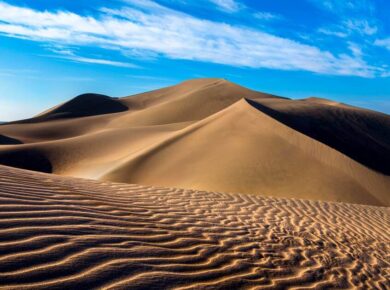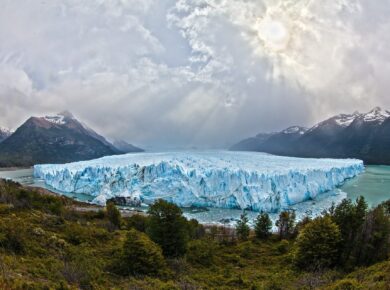Types of coasts
Types of coasts
Despite a great variety of coastal features, coastlines may be divided into two basic types –
| Coastline of Submergence |
|
| Coastline of Emergence |
|
Coastline of Submergence
Ria Coasts – Drowned river valleys
- During the ice age, a great deal of water was locked up in the ice, which melted as the climate got warmer leading to increase in sea level.
- In upland coastal regions, where the mountain runs at right angle to the sea i.e. transversely to the coast, a rise in the sea level submerges or drowns the lower parts of the valleys to form long narrow branching inlets separated by narrow headlands.
- Hence, a riais a coastal inlet formed by the partial submergence of an unglaciated river valley that remains open to the sea & is a coastline having several parallel rias separated by prominent ridges, extending a distance inland.
- The drowning of river valleys along a stretch of coast and formation of rias results in an extremely irregular and indented coastline.
- A ria coast differ from the fiords in two ways viz. they are not glaciated, & their depth increases seaward.
- All rias are generally backed by highlands & support few large commercial ports & extensively used for sitting fishing ports & naval bases.
Fjord coasts – Drowned glaciated valleys
- Fjords were created by glaciers that moved very slowly over time, and greatly altered the landscape once they have moved through an area carving deep valley
- Above process is called glaciation
- Fjord is formed when a glacier retreats, after carving its typical U-shaped valley with the sea filling the resulting valley floor
- It forms a narrow, steep sided inlet connected to the sea
- The terminal moraine pushed down the valley by the glacier is left underwater at the fjord’s entrance
- It causes the water at the neck or mouth of the fjord to be shallower than the main body of the fjord behind it
- Hence the opening toward the sea is often shallow & termed as threshold
Dalmatian coasts
- A longitudinal coast where the mountains run parallel to the coast
- Where the submergence of the coastline produces long, narrow inlets with a chain of islands parallel to the coast
- The elongated islands are the crests of former ranges & the narrow inlets were the former longitudinal valleys
- Like ria and fiord coasts, the mountainous nature of Dalmatian coastline hinders inland communication.
Estuarine Coasts
- Estuarine coasts are basically the coasts made by estuaries, with streams of river freely flowing into the sea, making them excellent sites for the ports.
- An estuaryis a partly enclosed coastal body of brackish water (salinity inbetween saline sea water & fresh river water) with one or more rivers or streams flowing into it, and with a free connection to the open sea.
- Estuaries form a transition zone between river environments and maritime environments.
- They are subject both to marine influences—such as tides, waves, and the influx of saline water—and to riverine influences—such as flows of fresh water and sediment.
Coastlines of Emergence
Uplifted lowland coasts
- The uplifted part of continental self produces gently sloping coastal lowland.
- The offshore waters are shallow with the lagoons, salt marshes & mudflats.
- Where the emerging deposits from the continental shelf are sandy & gravelly, beaches & marine dunes are formed.
- Ports that were once located on the former coast, became inland towns.
Emergent upland coasts
- Faulting & earth movement may thrust up coastal plateaus so that whole region is raised forming a raised beach.
- A raised beach is beyond the range of waves, though it may still possess arches, stacks & other coastal features.
- The emergent upland coast is quite straight with steep cliffs & deeper off shore waters.








